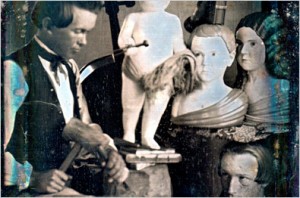AMES, ASA(1824–1851)
AMES, ASA is credited with at least eleven figural carvings that were created between 1847 and 1851. Based upon inscriptions that appear on many of the works, they appear to be specific portraits, primarily of children. Three-dimensional carving is an uncommon medium for this genre; typically, nineteenth-century portraiture was painted, andwoodcarving was the domain of trade-figure and ship carving. Although we do not know the nature of Ames’s training, one family remembered him as a seaman,suggesting perhaps that he may have learned to carve in a traditional ship-carving shop. The artist is highly regarded for his skill and his sensitive portrayals of youngchildren, although he carved some adult figures as well. His work is characterized by the careful depiction of details of costume and drapery; linear treatment of hair with repetitions of incised lines; deep-set eyes with lashes painted as a series of dots; and fully modeled ears.Ames first came to public notice in the seminal exhibition “American Folk Sculpture: The Work of Eighteenth and Nineteenth Century Craftsmen,” presented in 1931at the Newark Museum, New Jersey. At the time it was exhibited,
Bust of a Girl
was thought to be one of three portraits of sisters, and the artistwas incorrectly identified as Alexander Ames. It was not until 1977 that Jack T.Ericson located Asa Ames in the federal census of 1850 for Evans, Erie County, NewYork, where he listed his occupation as “sculpturing,” and was living in the household of Dr. Harvey Marvin. In 1847 the artist may have been living with another physician, Dr. Armstrong, when he carved the full-length figure of Amanda Clayanna Armstrong. That same year, he carved the three portraits thought to be of sisters,though they are more likely portraits of Millard F.Dewey and his sisters, Adelaide and Maria.Ames’s most ambitious work is a memorial to three-year-old Sarah Reliance Ayer and her one year old sister, Ann Augusta, who both died during an epidemic in1849. The memorial features a young girl seated with one arm around the lamb of Christ and a salver, or small tray, in her other, outstretched hand. The carving wascompleted in 1850, the year that Ames was living with Dr. Marvin in Evans. Marvin was a physician who was interested in alternative therapies such as the water cure,magnetism, and phrenology. Given this association, it is likely that the young artist carved the
Phrenological Head
about this time, and was perhaps seeking a cure for “lung fever,” or tuberculosis, a disease that was terminal in the age before antibiotics. Ames was unsuccessful, and died in 1851 at the age of twenty-seven years, sevenmonths, and seven days, as inscribed on his gravestone in the Evans Center Cemetery.
See also
Nautical Folk Art; Ship Figureheads;
Shop Figures; Trade Signs
.
BIBLIOGRAPHY
Ericson, Jack T. “Asa Ames, Sculptor.”
The Magazine Antiques,
vol. 122, no. 3 (September 1982): 522–529.Hollander, Stacy C. “Asa Ames and the Art of Phrenology.”
The Clarion,
vol. 14, no. 3 (summer 1989): 28–35

